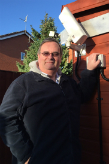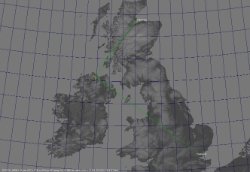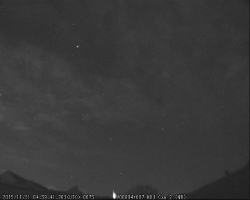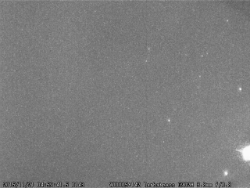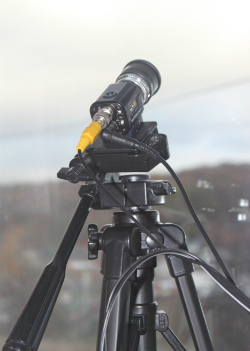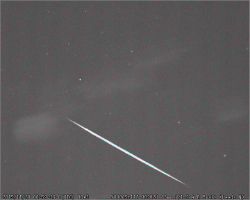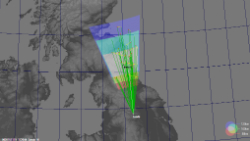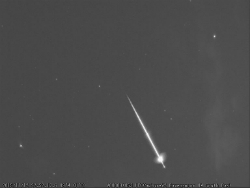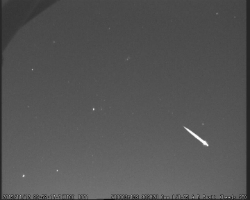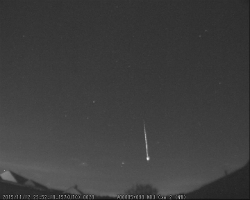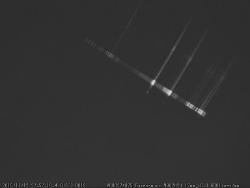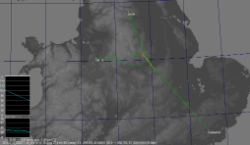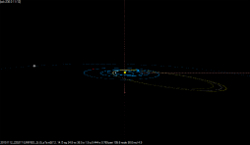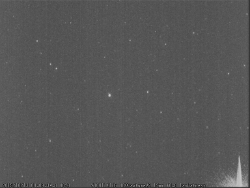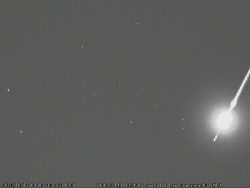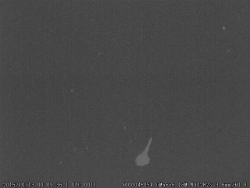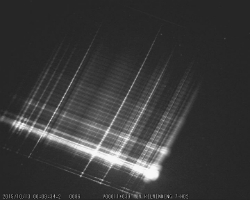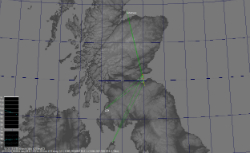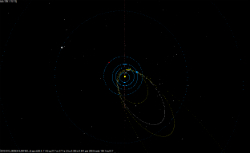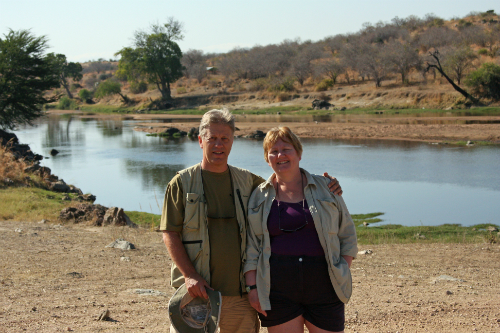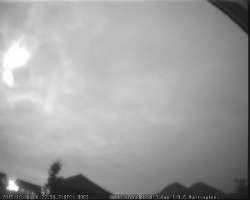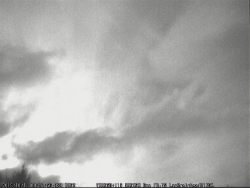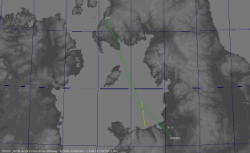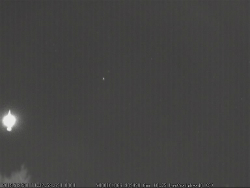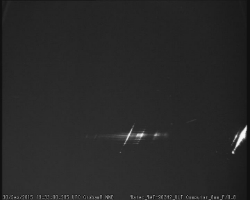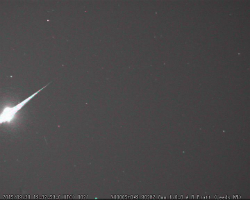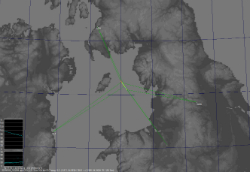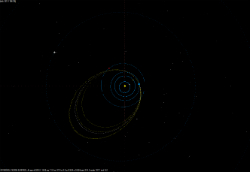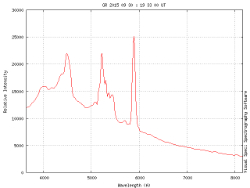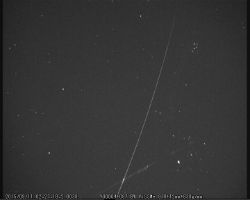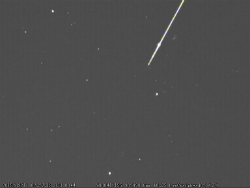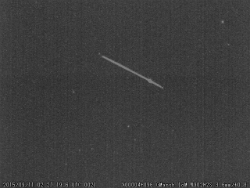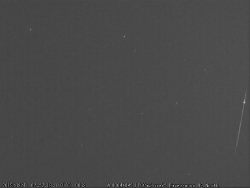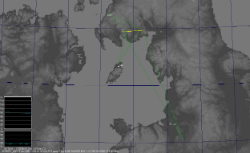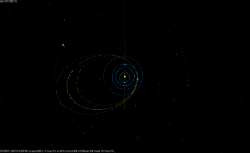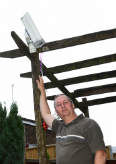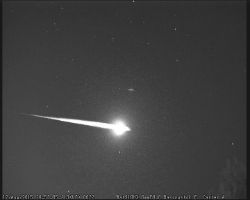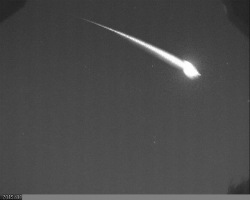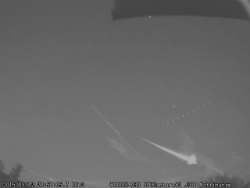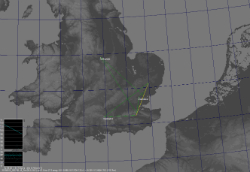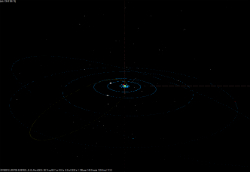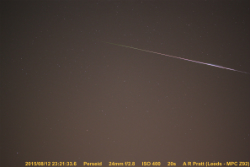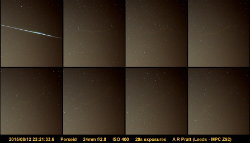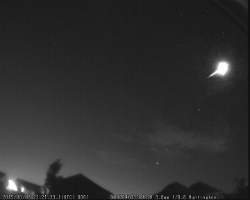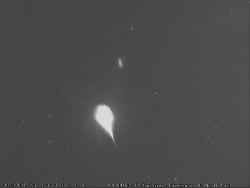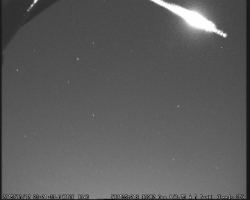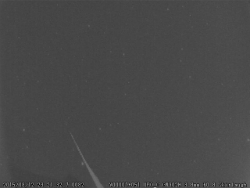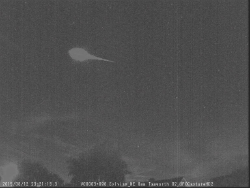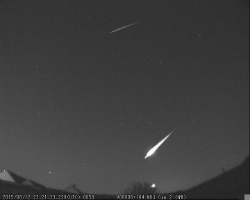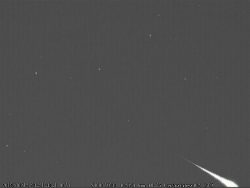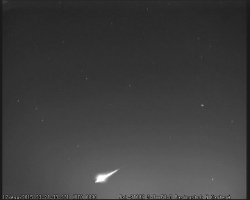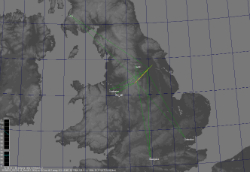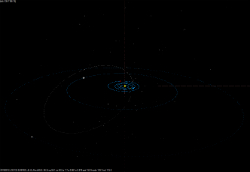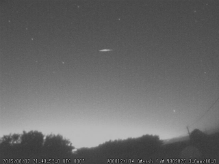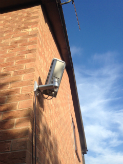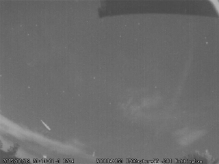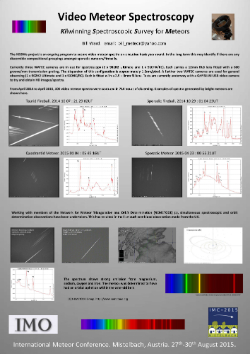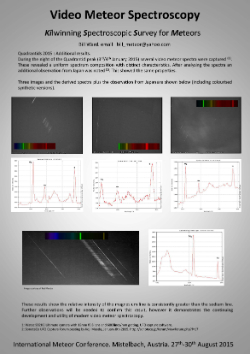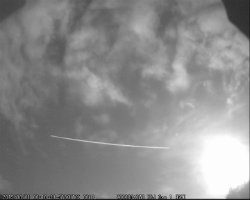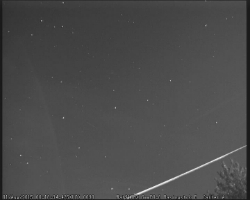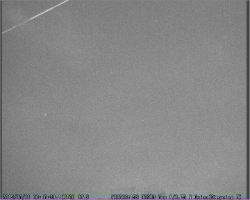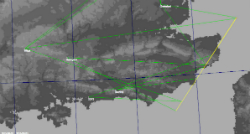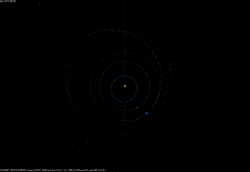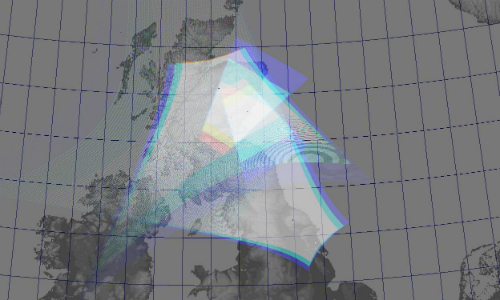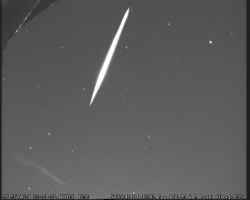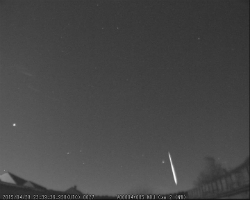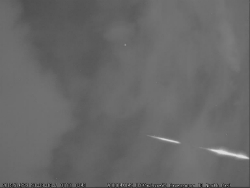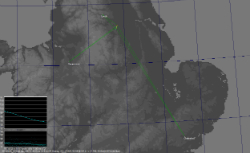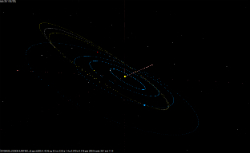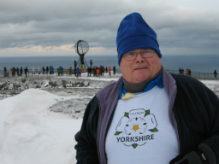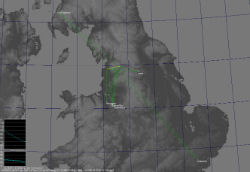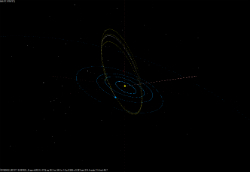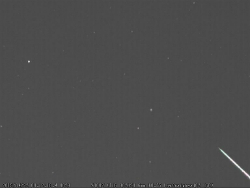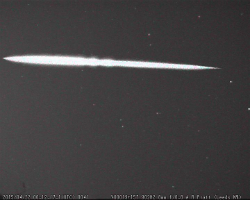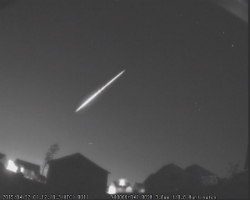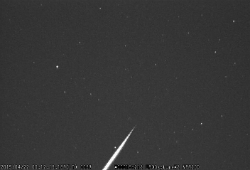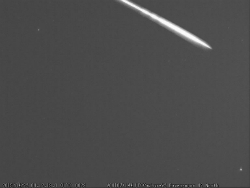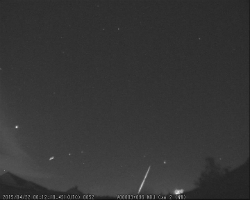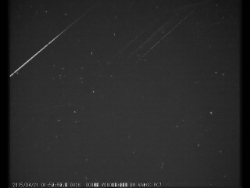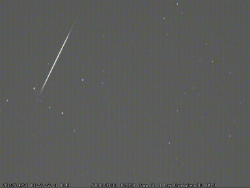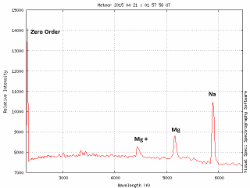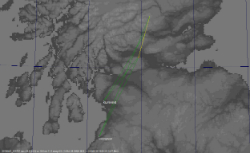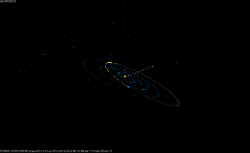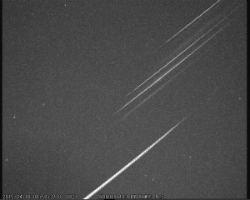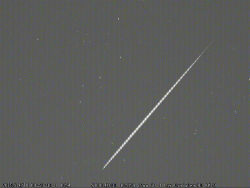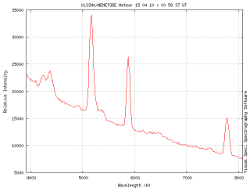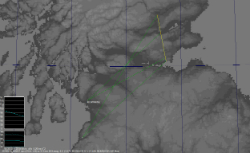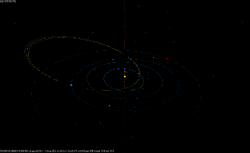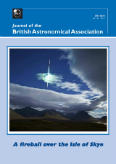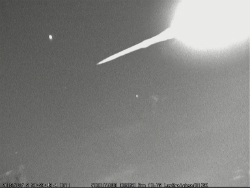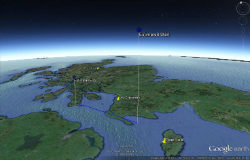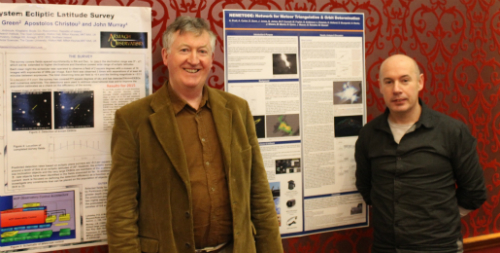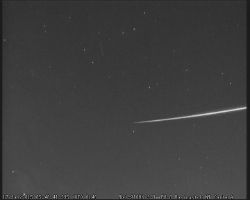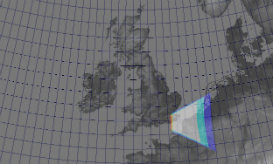Welcome to NEMETODE
Network for Meteor
Triangulation and Orbit Determination
Home: 2015
NEMETODE is a network of cameras based in the British Isles that monitor the night sky for meteors ("shooting stars"). Through the use of triangulation and timing the network is able to determine the actual trajectory and velocity of the meteoroids as they pass through the Earth's atmosphere. From this we are able to determine specific characteristics such as the radiant (that point in the sky from which each meteor appears to originate), how the position of this radiant varies with time and the parameters of the original solar orbit of the meteoroid (before the earth got in the way). We analyse our own data as we find this is an excellent feedback mechanism that deepens our understanding of the subject and enables us to optimise our detection capabilities. Our results are published in peer reviewed journals such as the Journal of the British Astronomical Association and WGN, the Journal of the International Meteor Organisation. Having completed our analysis, our data is uploaded to EDMOND for consolidation with other European groups. While we have excellent coverage over certain parts of the British Isles, there are still many gaps so please get in touch if you are interested in joining the group.
This page is the archive of the 2015 entries on the NEMETODE homepage. Other years can be accessed by clicking on the links below.
28th December 2015: Network Update: As we reach the end of 2015, I'm very pleased to welcome Martin Farmer to the team. Martin is based just to the north of Newcastle under Lyme in Staffordshire and has deployed a pair of cameras. The first is a Watec 910HX facing west-south-west while the other is a Watec 902H3 Ultimate facing north-east. Each is fitted with a Pentax 3-8mm lens. Please join me in welcoming Martin to the group.
In a seperate development, Allan Carter has deployed a fifth camera in Basingstoke. This one, a spectral system based around a Watec 910HX equipped with a Cosmicar Pentax 12mm f0.8 lens and a 600g/mm grating, is another valuable window into the fascinating world of meteoroid chemistry to complement those of Graham Roche & William Stewart. NEMETODE now comprises 31 observers and 51 cameras but we also have additonal observers / cameras on the cusp of coming online - stay tuned for further details.
26th November 2015: Latest Paper: The December 2015 issue of the Journal of the British Astronomical Association contains our latest paper "Quadrantids 2014 - Multi-station Meteor Videography". Previous papers are available here.
25th November 2015: Long Shot: The record (as far as we know) for the most distant simultaneous meteor observation within the British Isles has been broken with both Nick James' and Denis Buczynski's detection of an amag -3.6 Leonid on 21st November 2015 at 04:59:41 GMT. This was only just above the local horizon for Nick at a calculated distance of 642km from his camera in Chelmsford. Well done to both Nick & Denis! While observers in other parts of the world may have simultaneously observed more distant meteors, the size of the British Isles and the location of observers means that this one will be tough to beat.
All images and videos are available for individual personal use. The copyright resides with the authors and their written permission must be obtained in advance of any public and / or commercial use. |
||
21st November 2015: Coming in from the Cold: Alex Pratt has deployed a third camera from his home in Leeds. Keen to have a north facing camera to further augment the traingulation coverage supporting Bill Ward's spectroscopy observations, Alex was however unable to fit another exterior CCTV housing. Unperturbed, Alex has installed the system inside his house, looking out through an upstairs window. The Watec 902H2 Ultimate is coupled to a 12mm f1.2 lens, yielding a stellar limiting magnitude of +6.0, impressive considering the double glazing.
All images and videos are available for individual personal use. The copyright resides with the authors and their written permission must be obtained in advance of any public and / or commercial use. |
||
20th November 2015: TechNote #3: The latest in our series of Technical Notes is now out. TechNote #3 covers the topic of "Maintaining accurate time on a UFO Capture PC". Previous Technical Notes are available here.
16th November 2015: Not Only ... But Also: The deployment within the team of systems capable of capturing meteor spectra continues with the installation of a 4th camera by William Stewart at Ravensmoor, Cheshire. Based around a Watec 902H2 Ultimate and a Computar 12mm f0.8 lens, this setup includes a 600 g/mm diffraction grating and went live on 25th October 2015. Pointing north-east, it detects spectra from meteors that pass through that part of the ablation layer monitored by two of the other Ravensmoor cameras, thus increasing the probability that triangulation data with other stations can be combined with the spectral data. The focus needs a little tweak but since first light, a number of spectra have been captured including the amag -3.4 Southern Taurid shown below that occurred at 22:52:17 GMT on 12th November 2015. Bill Ward's sporadic of 13th October 2015 (00:09:35 GMT - see earlier posting) has, upon further review, a radiant that is close to that Taurid stream (trail maps are available here and here). This was sufficiently close to warrant a comparison of the spectra derived from each event. The similarities are remarkable though further investigation / analysis is required. Close inspection of the Ravensmoor spectrum shows the second order of the blue part of the spectrum, useful in that the increased dispersion helps seperate the closely spaced lines. For those interested in meteor spectra, we're putting the final touches to a Technical Note on the subject - stay tuned for details.
All images and videos are available for individual personal use. The copyright resides with the authors and their written permission must be obtained in advance of any public and / or commercial use. |
||
17th October 2015: The Best One Yet: Bill Wards's KiSSMe cameras have captured a very detailed spectrum of a magnitude -3.9 sporadic meteor that ablated over eastern Scotland on the 13th October 2015 at 00:09:35 GMT and once again NEMETODE the cameras of Denis Buczynski, David Anderson and Glyn Marsh have been able to assist in pinning down the atmospheric trajectory as well as generate an estimate of the orbit of the progenitor meteoroid. The level of details in the spectral lines is remarkable and we look forward to Bill's analysis - provisional details are available here.
All images and videos are available for individual personal use. The copyright resides with the authors and their written permission must be obtained in advance of any public and / or commercial use. |
||
16th October 2015: Hampshire Astronomy Group: We've very pleased to announce that Steve & Peta Bosley from Hampshire Astronomical Group have decided to join the NEMETODE and share the data from their three cameras with the team. Steve & Peta both have multi-year experience in operating video meteor detection systems and analysing the resultant data.
14th October 2015: A Tricky Fireball: On 11th October 2015 at 00:27:56 GMT a fireball was widely observed across the British Isles and even as far away as The Netherlands. The problem for many observers however was the extensive cloud clover that in most cases restricted the view to a series of flashes (one bright one followed by two fainter ones) as the cloud deck was illuminated from above by flares from the fragmenting meteoroid. Many cameras in the NEMETODE network detected these flashes but only two (Jon Jones in Huntinton and David Anderson in Low Craighead) had sufficient thinning of the clouds to allow the trajectory to be observed. The subsequent analysis proved to be a challenge as the light from the aforementioned flashes illuminated different parts of the image, confusing the analysis software - clicking on the images below will show problem. Through careful selection of key parts of certain video frames Alex Pratt has been able to determine the probable ground track that shows the meteor travelling south to north just off the north coast of Wales. It would appear that this event was a sporadic with an absolute magnitude of at least -7. Due to shortness of the analysed trails, this result should be treated with caution however it is consistent with the majority of reports on the Armagh & IMO Fireball pages.
All images and videos are available for individual personal use. The copyright resides with the authors and their written permission must be obtained in advance of any public and / or commercial use. |
||
02nd October 2015: Cameras, Cobwebs & Chemistry: We're very pleased to welcome Ken Ball and Frank Johns to the team, each of them having deployed a Watec 902H2 Supreme coupled to a Cosmicar / Pentax 6mm f0.75 lens. Ken is based in Hereford and is fine-tuning his azimuth / elevation. Frank resides in Newquay and his north-west facing camera provides excellent overlap with Allan Carter and Gordon Reineke, further enhancing coverage over the southern part of the Irish Sea. In addition, John Mason & Russ Slater have deployed a third camera at South Downs Planetarium. Of note is the "spider modification" implemented by Russ ... having removed the rain shield (which is superfluous to requirements anyway as the housing is pointed upwards), there is no longer an overhang from which spiders can spin their webs. The gap between the cover and housing has also been filled with foam so that there is no longer a convenient warm, dry habitat. Web-spinning spiders can trigger the motion detection software used in the system and initial indications are tha these modifications have been very successful at preventing them from taking up residence in or on the camera housings. These three additional cameras brings the network total to 42 cameras.
In addition, Graham Roche has fitted a 600 lines / mm diffraction grating to the front of his camera system and is obtained excellent spectral data. Of particular note is the fireball of 30th September 2015 at 19:32:59 GMT. It is truly remarkable how quickly the discipline of video meteor analysis is advancing. Having spent billions of years obiting the sun either as an individual particle or part of a larger body, we are able to accurately detemine the orbital parameters, atmospheric trajectory and chemical composition of a meteor using relatively inexpensive equipment. On this occasion the team collaboration was superb and these parameters were identified within a couple of hours of the event occurring - special thanks to Bill Ward for the provisional identification of iron and/or magnesium in the green part of the spectrum. The orbit has a Tisserand Parameter of 3.17 suggesting that the meteoroid was asteroidal in origin. Tony Markham has a writeup of this event on the SPA website while additional visual observations are on the Armagh and IMO fireball pages. With further spectral systems coming online soon, this pioneering work of Bill Ward and Graham Roche here in the British Isles is quickly becoming mainstream.
All images and videos are available for individual personal use. The copyright resides with the authors and their written permission must be obtained in advance of any public and / or commercial use. |
||
14th September 2015: Another KiSSMe / NEMETODE Spectorbital: Further to the results of 10th and 21st April 2015 (see below), the collaboration between Bill Ward’s KiSSMe (Kilwinning Spectroscopic Survey for Meteors) and NEMETODE has resulted in another fascinating observation, specifically a meteor that occurred at 02:27:19 GMT on Friday 11th September 2015. The data captured by Glyn Marsh, David Anderson and William Stewart has facilitated an estimate for the atmospheric trajectory and orbit: the meteor entered the atmosphere at a shallow angle and lasted 4s – see images and videos below. A sporadic meteor with an absolute magnitude of -1.9, it was probably asteroidal in origin. Bill’s spectral analysis (see imagery below) shows that for the duration of the event, a very bright sodium line and fainter magnesium line were visible with a series of iron lines flashing into view during the explosion towards the end of the event.
Of particular interest is that fact that useable spectra can be obtained from just bright meteors (which are more plentiful that their fireball-class cousins) and hence, with the roll-out of additional spectral systems (which a number of members of the team are considering / building / have already deployed), we should in the coming years be able to build a statistically significant catalogue from which further good science can be gleaned. Well done to everyone involved, especially Glyn who has only been up and running for just over a month!
All images and videos are available for individual personal use. The copyright resides with the authors and their written permission must be obtained in advance of any public and / or commercial use. |
||
30th August 2015: Welcome to Martin: Today we're very pleased to announce that Martin Kessel has joined the team. Martin is based in the eastern suburbs of Stoke-on-Trent in Staffordshire and has been operating a meteor video detection system since 2009. Having recently upgraded his system with a 6mm f0.75 Cosmicar Pentax lens, Martin has seen a significant improvement in his detection capabilities, in spite of the local light pollution. Martin will be giving a talk relating to his system on Tuesday 01st September 2015 at North Staffordshire Astronomical Society - anyone in the local area interested in hearing more is very welcome to attend. In the meantime, please join me in welcoming Martin to the group.
26th August 2015: Perseid Fireball (2 of 2): Further to the previous update, we have now received the data to allow the ground track and orbit of the other Perseid fireball that was observed on the night of the 12th August at 20:57:05 GMT (many of our observers leave their systems running, even when away from home, and hence the retrieval of the data may take a few days until their return). This was a magnitude -5.8 event picked up by Allan Carter, Nick James and James Dawson. We also have the .kml file to allow the atmospheric trajectory and ground track to be viewed in Google Earth.
All images and videos are available for individual personal use. The copyright resides with the authors and their written permission must be obtained in advance of any public and / or commercial use. |
||
18th August 2015: Perseid Fireball (1 of 2): Thankfully the weather cleared for many members of the team on the night of the Perseid maximum and right now everyone is busy working through their data which will go towards an upcoming paper. In the meantime we wanted to share a couple of spectaculars from this year's show. The first occurred on 12th August 2015 at 23:21:32 GMT and is notable not only because it was a magnitude -5.4 Perseid fireball imaged by no fewer than eight members of the team but also because Alex Pratt imaged it and the resulting persistent train with a DSLR. Alex's animation was derived from 19 exposures, each of 20s duration. The first 8 exposures were used to produce the montage. Click on the images below for the show from each location. We also have the .kml file to allow the atmospheric trajectory and ground track to be viewed in Google Earth.
All images and videos are available for individual personal use. The copyright resides with the authors and their written permission must be obtained in advance of any public and / or commercial use. |
||
10th August 2015: And Glyn is Now Online Too!: Further to today's earlier announcement, we're very pleased to welcome Dr Glyn Marsh to the team. Glyn has been commissioning his new system (Watec 902H2 Supreme with a Computar 3.6mm lens) at his home in Ballakinnag on the Isle of Man for the past couple of weeks. Aligned on an azimuth of 349.5 degrees from the north coast of the island, Glyn is looking out over some of the darkest skies in the Britsh Isles. Again, it's another valuable addition to the network just in time for the maximum of the Perseids. Please join me in welcoming Glyn to the team!
10th August 2015: James Goes Live!: We're very pleased to once again welcome a new observer to the team. James Dawson is based in Nottingham and in the past few days has deployed a Watec 902H2 Supreme coupled to a Cosmicar Pentax 3.8mm f0.8 lens. Local light pollution has proved somewhat of a challenge but through careful alignment James has managed to select an azimuth and elevation that avoids the majority of local hazards to astronomy while at the same time enhancing coverage over south-east England. With the commissioning phase just about over, James is all set to make valuable contributions, just in time for the maximum of the Perseids (see the magnitude +0.6 example he caught in the video below). Please join me in welcoming James to the team!
06th August 2015: IMC 2015: Bill Ward (KiSSMe) will be presenting two posters relating to Video Meteor Spectroscopy at the International Meteor Conference that is taking place in Mistelbach, Austria from the 27th - 30th August 2015. One of Bill's posters references the NEMETODE collaboration (which is increasing as a result of the additional deployments / realignments mentioned in the 03rd August 2015 update and has been highlighted in earlier postings) - click on the images below for details. Best wishes to Bill on his travels and presentations!
04th August 2015: Long & Slow: While not especially bright, a magnitude -0.6 sporadic from 00:18:34 GMT on 01st August 2015 is notable as a result of its very low Geocentric Velocity (Vg) of 5.9km/s. Observed by Nick James (Chelmsford, Top), Allan Carter (Basingstoke, Left), Nick Quinn (Steyning, Right) and John Mason / Russ Slater (South Downs Planetarium, Chichester) it had a duration of over 9 seconds. It was also detected by Richard Fleet (UKMON, Wilcot). Nick reports that "It was so slow that UFO Capture cut off before the end of the track on both the Chelmsford and Wilcott cameras but it shows a nice persistent train on the video. The orbit is prograde, nearly in the plane of the ecliptic, with a perihelion at Earth's orbit and aphelion at Mars. I've checked the list of Apollo and Amor minor planets but nothing shows up as a possible match for the parent". The fact that the orbit was prograde helps to explain the low Vg: the meteoroid had to catch up with the Earth as it travelled along in its orbit. A review of the .kml file (for Google Earth) also helps to explain the long duration - note the very shallow entry angle of 2.6 degrees which meant that it skimmed along the top of the earth's atmosphere. A steeper entry profile would have resulted it a shorter path and duration ... but a brighter meteor.
All images and videos are available for individual personal use. The copyright resides with the authors and their written permission must be obtained in advance of any public and / or commercial use. |
||
03rd August 2015: KiSSMe / NEMETODE Update: We are very pleased to announce that the collaboration between Bill Ward's KiSSMe (Kilwinning Spectroscopic Survey for Meteors) and the NEMETODE team has received a significant boost. Not only has Denis Buczynski realigned his existing 12mm camera, he has also deployed a second camera, this one with a 3.8mm lens. In combination with the existing alignments of David Anderson and Ray Taylor, there is now very good meteor ablation coverage over eastern Scotland, the preferred area over which Bill operates his KiSSMe System. This should significantly increase the likelihood of obtaining good triangulation data for those meteors for which Bill obtains spectra.
27th July 2015: Latest Paper ... and a Busy Team: Just in time for one of the more prominent showers of the year, the August 2015 issue of the Journal of the British Astronomical Association contains our latest paper "Perseids 2013 - Multi-station Meteor Videography". With the growth in the network we're happy to note the inclusion of additional co-authors (Mike Foylan & Michael O'Connell), something we expect to continue with future papers. Speaking of expansion, members of the team have been busy in recent weeks adding additional cameras, upgrading existing systems with more sensitive cameras and lenses and also realigning their setups in order to further optimise the science opportunity. With darker skies returning following the summer solstice, these new configurations are currently being fine tuned for maximum capability. In addition, new observers have recently received their systems and expect to come online in the coming weeks, again just time for the Perseids maximum. Stay tuned for details. In the meantime, many members of the team will be at the "BAA Observers Workshop: Comets and Meteors" event in London on Saturday 26th September 2015 - spaces are limited so if you are interested in attending, please register soon.
18th May 2015: Technical Note #02: In January of this year we released the first in our series of Technical Notes (Watec 902 & 910 Series Cameras). This series of documents consolidates key information relating to some of the equipment in use within the network. Today we're pleased to publish the second in the series, "Troubleshooting Resolution Issues". This Technical Note provides background information relating to video standards and details workflows for optimising resolution settings when using different combinations of cameras and video capture devices. As before, this has been a team effort so many thanks to everyone who has contributed. In the meantime if you have any questions or comments, please get in touch.
17th May 2015 : NEMETODE's 2013 Dataset is now available: The combined .csv file encompassing all meteor observations recorded by the cameras of the NEMETODE network during the period 01st January 2013 to 31st December 2013 is now available here. During this period there were 13302 individual meteor detections with 781 "Q1 Level" common events from four stations and five cameras. Thanks as ever to all the contributors who have collected and analysed this data and who have agreed to make it available.
06th May 2015: BAA Meteor Section Meeting: On Saturday 09th May 2015, the BAA Meteor Section will be holding an all day meeting in Birmingham. As per the agenda, there will be discussions / presentations on multiple meteor observation techniques, as well as results from recent analyses. The event is free and everyone is welcome.
04th May 2015: Fantastic Fragmenter: While not especially bright, a magnitude -2.3 sporadic from 23:39:36 GMT on 29th April 2015 is notable for the fragmentation that it underwent while ablating. Although the event was imaged from Essex and Cheshire, it is Alex Pratt's video from Leeds which shows this event at it's best.
All images and videos are available for individual personal use. The copyright resides with the authors and their written permission must be obtained in advance of any public and / or commercial use. |
||
03rd May 2015: Northern Expansion: NEMETODE's meteor ablation layer coverage continues to grow as we welcome Ray Taylor to the team. Ray is based near Skirlaugh in North Yorkshire and has recently achieved "first light" with a Genwac 902H coupled to a Cosmicar / Pentac 3.6mm f0.8 lens. His north-west facing alignment is another welcome addition and provides enhanced coverage over Durham, Northumberland and Southern Scotland and may well assist in providing triangulation data for Bill Ward's KISSME. As ever, we're looking forward to the science that will flow from Ray's system. Welcome aboard!
24th April 2015: Hexavision: With the exception of particularly spectacular events, we normally wait until everyone has analysed their data for the month before reviewing our multi-station captures. However a tweet from Tony Markham and another from Noel Blaney had us looking into our data a little earlier than usual. Although not particularly bright (only a -2.7 Sporadic), this meteor from 00:12:17 GMT on 22nd April 2015 turned out to be notable for the fact that it was observed from six separate NEMETODE cameras with Alex's camera in Leeds framing it perfectly. Although the initial visual report suggested it was a Lyrid (back tracing the trajectory took it towards the active radiant), the multi-station analysis demonstrated that the geocentric velocity and orbital inclination were not a good match with Comet Thatcher, the parent of the Lyrid debris stream. In additional to demonstrating the extensive coverage of the meteor ablation layer over the British Isles, this observation also hints at future possibilities:
For many decades meteors have been recorded visually by dedicated observers who have diligently braved the cold to sit out and document what they have seen. In recent years there has been a dramatic increase in the use of automated photographic and video techniques. At the same time the number of visual observers has decreased significantly. Establishing a solid relationship between what is typically seen visually and what is captured using photographic / video techniques is essential if we are to ensure we can draw reliable conclusions as to how meteor showers evolve over time. Comparing the results obtained by dedicated observers such as Tony against the video data from networks such as NEMETODE may allow us to begin establishing such a relationship.
All images and videos are available for individual personal use. The copyright resides with the authors and their written permission must be obtained in advance of any public and / or commercial use. |
||
24th April 2015: Bill & David do it Again: On 21st April 2015 at 01:57:57 GMT another sporadic meteor was captured by Bill Ward's KISSME system. David Anderson's video system also imaged it and so for the second time in a fortnight we have triangulation and spectral data on a meteor. It really does look like we have an effective collaboration in place for this sort of work. Well done to everyone concerned!
All images and videos are available for individual personal use. The copyright resides with the authors and their written permission must be obtained in advance of any public and / or commercial use. |
||
12th April 2015: Spectorbital: For the past few years the NEMETODE team have been working closely with Bill Ward (based in Kilwinning, Scotland) in order to try and obtain triangulation data on meteors for which Bill has obtained spectral data. Up to now various factors including ablation layer coverage, moonlight and patchy weather have consipred against this endeavour. A few weeks ago however David Anderson and Denis Buczynski realigned their cameras to try and improve the chances of a simultaneous capture with Bill and at 00:58:37 GMT on Friday 10th April 2015 they had a hit when David Anderson imaged the same meteor as Bill's spectral capture system. There's a good chance that Denis has it too ... but today he's speaking at the BAA Winchester Weekend and he won't be able to check his automated system for a few days!
Using data from Bill and David we've been able to generate a provisional trajectory and orbit for this magnitude -2.2 sporadic though the Q-Angle is less than ideal hence this is a provisional result - if Denis has it too then we'll be able to produce a result in which we have more confidence. Bill's analysis suggests it is probably a stony-iron which is consistent with an object that is asteroidal in origin ... this ties in nicely with the provisional low inclination orbit that has an aphelion between Mars and Jupiter.
On a personal note we're absolutely delighted with this result. While we suspect this is the first simultaneous observation of this type from the British Isles (if not then please let us know), it was Bill's Meteor Observers' Forum that ultimately led to the creation of the NEMETODE team and we see this as a long overdue "thanks" to Bill: obtaining spectral data on meteors requires skill and tenacity and it is testament to Bill's perserverence that he's now obtaining spectra on a regular basis with equipment he's designed and built himself. The NEMETODE team are more than happy to augment the science Bill is generating with trajectory and orbit data!
The images below show Bill's meteor image (with the meteor at the bottom and the spectral lines to the upper right), David's image, Bill's spectral analysis (KISSME is the acronym for KIlwinning Spectroscopic Survey for MEteors) and the provisional ground track and orbit. A kml file of the trajectory is available here while more of Bill's spectral captures from other events are available on the Meteor Observers' Forum and the BAA Forum. A richly deserved "Well Done!" to everyone involved - as ever we're all looking forward to the upcoming science and many more similar captures in the future.
All images and videos are available for individual personal use. The copyright resides with the authors and their written permission must be obtained in advance of any public and / or commercial use. |
||
04th April 2015: Latest paper makes the April JBAA Cover: A beautiful image of the the fireball over central Scotland on 14th October 2013 makes the front cover of the J. Br. Astron. Assoc. This image was key to the analysis detailed in the resulting paper. The smoke-trail animation (at 0.15s per frame) is available here. Original imagery is courtesy of Marcus McAdam, his full frame animation is available here. David Anderson's video of the event is here while the complete version of Figure 7 (including the arrow) is here. Click on the image below for the paper itself.
25th March 2015: Loch Ness Fireball Update: On Saturday 21st March 2015 Douglas Anderson, Dr David Anderson and Peter McIver were given permission to have a look around the runways, aprons and carparks at Machrihanish Airbase just in case the fireball had dropped fragments downrange from where the terminal flash occurred. This area was chosen due to its proximity to the anticipated dark flight ground track and the fact that the clear, flat areas would be relatively easy to search. David did bring along some meteorites to show others what to look for (these are shown, together with other photographs, here but please note these are samples brought along on the day: nothing resembling a meteorite was found during the search). It is important to stress that the chances that fragments did reach the ground are slim but anyone finding unusual rocks close to the ground track are asked to get in touch.
19th March 2015: A long way from Loch Ness! At 20:59:49 GMT on Sunday 15th March 2015 a fireball was widely observed from many parts of the United Kingdom resulting in multiple online reports (see here and here). Unfortunately there was extensive cloud cover over all NEMETODE cameras ... except for one operated by David Anderson. Not long before the event David had made his setup fully automated so that it would operate autonomously even if he was away from home. This proved fortuitous as the event occured while David was in Norway observing aurora. It wasn't until he returned home the following Tuesday that he discovered he'd captured the early stages of the event. High resolution still images of the event were also captured by John MacDonald from Loch Ness (leading to this event becoming known as the "Loch Ness Fireball" due to the media publicity associated with the image) and by David Corkish from the Isle of Man.
By combining the three observations it has been possible to estimate the trajectory and ground track of the fireball. Investigations are ongoing but it currently appears to have first become visible at 20:59:48.9 GMT at 54° 38' N, 04° 46' W at an altitude of 95km before heading on a bearing of 326°, ending with a terminal flare 8.2s later at 55° 23' N, 05° 38' W at an altitude of 33km. The zenith angle was around 58°. Total observed path length was 117km yielding an average velocity of 14.3km/s. Analysis of David Anderson's video and of John MacDonald's image both result in a magnitude estimate of -10
David Anderson's video of the event, together with an image of the estimated trajectory and ground track are available below.
27th February 2015: New Observers & Additonal Cameras: The growth in the network seen last year continues into 2015 with two new observers joining the network. In recent days David Dunn achieved first light with his camera in Normandy, France - this system provides valuable coverage off the coast of south-east England at a particularly favourable overlap angle to existing cameras within the network. Meanwhile Jon Jones has also recorded his first meteors with a camera based near Chester, England. Facing north-north-east, this system facilitates excellent ablation layer coverage (again, at a perfect overlap angle with existing observers) over the far north-east of England. Please join me in welcoming David & Jon to the group - as ever we're looking forward to the additional science these systems will yield. Last but by no means least, Allan Carter has recently commissioned a third camera from his location in Basingstoke - this system opens up coverage over south-west England and is again a very welcome addition to the network. Well done Allan! This deployment lifts the overall number of cameras in the network to 34 across a team of 21 observers. Stay tuned for updates as additional system deployments together with realignments of existing cameras (all in support of boosting the science return) are expected to occur in the coming weeks.
26th February 2015: Galway Astronomy Festival: On Saturday 21st February 2015 Mike Foylan attended the Galway Astronomy Festival (hosted by Galway Astronomy Club) and took the opportunity to share the NEMETODE Poster Paper he has authored. This paper, together with selection of about 35 meteor videos in a continuous loop and an all sky camera in live mode, garnered significant interest and may lead to addtional observers in Ireland. The picture below shows Dr. Eamonn Ansbro with his poster paper on "Edgeworth-Kuiper Belt Objects - An Outer Solar System High Ecliptic Latitude Survey" on the left and Mike with the NEMETODE paper on the right. Mike plans to attend the upcoming COSMOS 2015 three day astronomy festival in Athlone and have a stand there displaying our work - if you're in the area you're very welcome to stop by. With many thanks to Mike for his hard work on this and for sharing the image below.
28th January 2015: Double Tap: Our latest paper "Eta Aquarids 2013 - Dual-Station Meteor Videography" has just been published in the January 2015 issue of the Journal of the British Astronomical Association - a .pdf is available here. Within the Observers' Forum of the same issue of the journal is an overview of the NROL 35 fuel caught on the Ravensmoor SE Camera back on the 13th December 2014 - again a .pdf is available here.
27th January 2015: NEMETODE Technical Notes: For many years Watec has been the manufacturer of choice when it comes to serious video meteor detection work. Other cameras are available and indeed good results can be obtained using other manufacturers such as Minitron. As it turns out, NEMETODE members all use Watec and over time members of the team have built a wealth of knowledge / experience in the use of these cameras. While much of this information is available elsewhere, there is no good central repository for it and hence we have decided to consolidate it into a single document, specifically NEMETODE Technical Note #01: Watec 902 & 910 Series Cameras. As the name suggests, this is the first in a series of documents that pull together key information that is likely to be of use / interest to video meteor observers. Please feel free to downloand and have a read through ... and if you have any questions / comments, please let us know. The expecation is that this document will be updated as and when new information becomes available.
17th January 2015: Long and Slow: At 05:48:41 GMT on 17th January 2015 an unusually slow and long lasting meteor was observed by Allan Carter (Basingstoke) and Nick James (Chelmsford) passing over south-east England. While not particularly bright, the fact that it lasted over 8 seconds is unusual - towards the end it fragmented and left a wake. Additional imagery, videos and analysis are available here.
06th January 2015: New Year, New Observer: A belated Happy 2015 to everyone! We're pleased to announce that the New Year has brought an additional observer as Nick Quinn, a highly experienced imager based in Steyning, West Sussex has joined the group with a Watec 902H3 Ultimate coupled to a 4mm Computar lens and has already provided valuable data. Nick's ablation layer coverage brings additional overlap with Nick James' south-east facing camera enabling triangulation data to be obtained for meteors coming in off the coast of SE England. Welcome aboard Nick - as ever, looking forward to seeing further results from your system.
